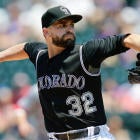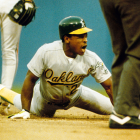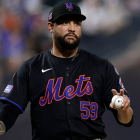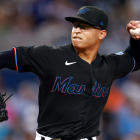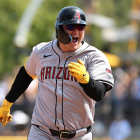Black Friday is the best shopping day of the year. It is also the craziest shopping day of the year -- you have to get up early and wait on long lines for the very best buys -- but it's hard to beat the deals you'll find the day after Thanksgiving. No matter whether you're looking to get a head start on holiday shopping or want to treat yourself, there's something for everyone on Black Friday.
We're all still waiting for the MLB offseason to really kick it into gear -- this offseason has been very slow compared to the last few years -- but you can be sure teams are already scouring the free agent market for bargains. That starts as soon as the World Series ends. Probably sooner. So, on this Black Friday, here are four potential bargain free agents sitting out there waiting to be signed.
Tommy John surgery -- his second career Tommy John surgery -- cost Tyler Chatwood the entire 2015 season, and when he returned, he had the unfortunate privilege of pitching at Coors Field. His overall numbers with the Rockies from 2016-17: 4.27 ERA (115 ERA+) in 305 2/3 innings. Now his home/road splits:
IP | ERA | WHIP | FIP | K/9 | BB/9 | HR/9 | GB% | |
Home | 148 1/3 | 6.07 | 1.66 | 5.03 | 6.9 | 4.3 | 1.3 | 58.4% |
Road | 157 1/3 | 2.57 | 1.17 | 4.23 | 7.0 | 4.4 | 0.8 | 56.8% |
Now, I don't think it's fair to assume any player's numbers away from Coors Field represent who he truly is, but obviously playing at altitude will skew performance. In Chatwood's case, his home/road split is so extreme that you can't help but think he'll perform better with a new home ballpark. As good as his 2.57 ERA on the road the last two years? Probably not. But surely there's a happy medium somewhere.
More than his road performance, the biggest reason to believe Chatwood is a potential bargain is his elite curveball spin rate. Since returning from Tommy John surgery his curveball spin rate is an incredible 2,952 rpm, well above the 2,477 rpm MLB average and fourth highest among the 164 pitchers who threw at least 300 curveballs from 2016-17. Chatwood's curveball is an elite pitch, at least in terms of rotation.
The Astros used curveball spin rate to take Charlie Morton's game to the next level this season -- Morton had a 2,884 rpm curveball spin rate from 2016-17 -- and you can be sure some team will try to do the same with Chatwood. In fact, he's already drawing plenty of interest.
Free agent Tyler Chatwood -- 3.49 ERA and .695 opponents' OPS away from Coors Field in 2017 -- is drawing widespread interest from @MLB clubs. One source predicted a multiyear deal is probable for the right-hander, who turns 28 next month. @MLBNetwork
— Jon Morosi (@jonmorosi) November 19, 2017
There is plenty of risk with Chatwood. His track record isn't long at all, his walk problems aren't limited to Coors Field, and he has two Tommy John surgeries in his history. There's no such thing as a potential bargain free agent without risk though. Some club is going to gamble on the still only 27-year-old Chatwood being an above-average starter away from Coors Field, and they could be rewarded handsomely.
The free agent market has been rough on one-dimensional sluggers the last few seasons, so inevitably there will be bargains to be had late in the offseason. Last offseason Logan Morrison and Adam Lind signed in February and turned into nice pickups for the Rays and Nationals, respectively.
Lucas Duda, who hit .217/.322/.496 with 30 home runs in 127 games around an elbow injury with the Mets and Rays in 2017, stands out as the best bet for a bargain first-base bat this winter. He had long crushed right-handed pitchers -- Duda is a career .249/.356/.486 hitter against righties -- and is further away from his 2016 back injury, which could help his performance going forward.
Furthermore, the 31-year-old Duda still produces excellent exit velocities, posting an average exit velocity of 95.2 mph on fly balls and line drives this season. That's well above the 92.1 mph league average, and on par with players like Bryce Harper (95.3 mph), Corey Seager (94.9 mph), and Carlos Correa (94.9 mph).
The days of teams paying big for non-elite first base/DH types are long gone. Guys like Duda, Morrison, Lind, Yonder Alonso, and Mitch Moreland are all free agents with few first base and DH jobs available. Duda has a chance to give a team premium power production on a one-year contract.
Howie Kendrick never did become the batting title machine he was projected to be in the minors -- Kendrick's lowest full season batting average in the minors was .363 in 2004 -- though he has been an above-average regular for a long time. These days he's settled in as a very good part-time player who can start in a pinch.
This season the 34-year-old Kendrick authored a .315/.368/.475 batting line with nine homers and 12 steals in 91 games for the Phillies and Nationals, and he did that while playing four positions (first base, second base, left field, right field). He also has recent experience at third base, playing 17 games there in 2016.
Kendrick still annihilates left-handers (.322/.390/.511 in 2017) and his newfound versatility makes him a prime target for contending teams looking for a high-end bench player or super-sub. Someone you can put in the lineup three or four times a week at different positions without taking a big hit offensively.
I don't think Kendrick will be available on a one-year contract, but a two-year guarantee at $6 million to $8 million per season seems doable. Adding a productive part-timer like Kendrick at that price is a move some contender will be very happy they made this year.
Joe Smith, now 33, has spent parts of 11 seasons in the big leagues, and this summer he returned to the Indians following a trade deadline deal with the Blue Jays. He played in Cleveland from 2009-13 before signing with the Angels as a free agent.
Smith was a very different pitcher in his second stint with the Indians -- and a different pitcher in 2017 in general -- than he was the first time around, mostly by changing his pitch selection. The sidewinder scaled back on his trademark sinker and started elevating his four-seam fastball more often.
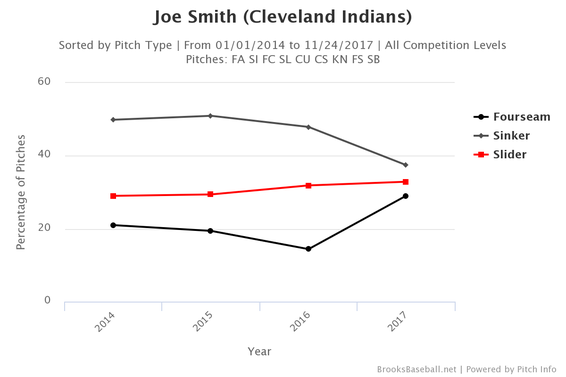
From 2014-16, Smith struck out 21.3 percent of batters faced, which is more or less league average. From 2009-13, his first stint with the Indians, he struck out 19.2 percent of batters faced. This season though, Smith used those elevated fastballs to strike out a career-high 33.2 percent of batters faced.
Elevated fastballs are a great swing-and-miss pitcher, and hitters are not used to seeing a fastball at their eyes from a sidearmer. Check out the pitch locations of Smith's strike-threes on four-seamers:
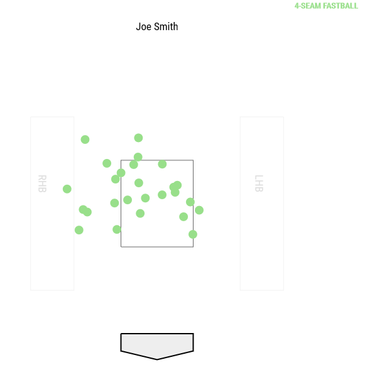
Smith was able to increase his strikeout rate without sacrificing his walk rate (4.7 percent) or ground ball rate (49.6 percent), both of which were quite a bit better than the league average. His 3.33 ERA was strong and his 2.10 FIP was ninth lowest among the 150 relievers who threw at least 50 innings in 2017.
Relievers are notoriously fickle. They dominate one year and implode the next. In Smith's case, he had been solid for a decade now, and there is a tangible reason to believe his strikeout rate this season is legitimate improvement and not a fluke. Smith has changed his pitch selection, and now he combines an excellent strikeout rate with his typically strong walk and grounder rates.
With bullpens growing more and more important each season, a smart team is going to sign Smith to a middle reliever contract and get setup man or even closer production next season.














